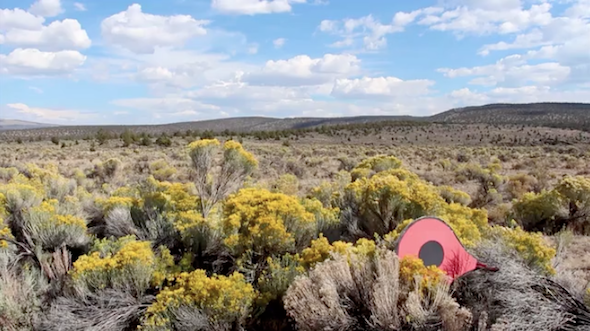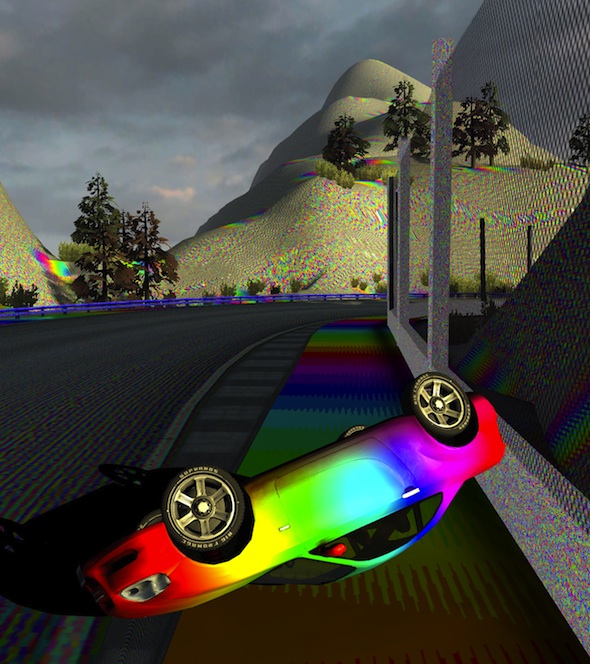 Rick Silva – “Locals Only,” video still
Rick Silva – “Locals Only,” video still
Article by Alison Hugill in Berlin; Saturday, Oct. 19, 2013
The physical gallery space is almost completely superfluous to this exhibition. It serves merely as a portal, an exclusive place from which to gain access to the digitally-housed artworks. When you enter the empty rooms of km temporaer, you enter the network. The exhibition exposes the modern experience of being dependent on a spatial setting, yet completely absorbed in a mobile device and an online world. This is not an uncommon phenomenon in our daily lives, always on the hunt for wireless access, but the disjuncture of the real and the virtual seems so much more stark against the backdrop of the white-walled gallery space.
The concept for local.#non.access was developed by Florian Kuhlmann and curated in collaboration with Elisa Linn and Lennart Wolff. The idea was to present a ‘media plastic,’ described by the curators as a “sculpture made out of pure information.” The website, which can only be entered from the gallery location, features the work of 20 international new media and web-based artists, with a thematic focus on ‘access.’ Dutch artist Jan Robert Leegte, for example, has created a piece for local.#non.access that registers the visitors’ connection to his site by gradually filling up the user’s webpage with a blue colour. Each time a new person accesses his site, the blue dissipates from the previous viewer’s screen and fills the latest. In this way, his piece ripples digitally through the gallery like a wave and varies in speed depending on how many people are accessing the site at once.
Rick Silva, a Canadian web-based artist, has produced a video for the show, which emulates the ‘pin drop’ function of Google Maps applications. Silva throws life-sized cardboard cutouts of this iconic image into real nature. The locations of the pin drops are unknown but the piece tries to realize this ubiquitous digital positioning tool on a real scale. Much like the whole exhibition itself, the outcome is at once absurd and thought-provoking. The many functions of the Internet, which we are so dependent upon in our everyday lives, become comical and nonsensical when displaced into the non-virtual world.
 Constant Dullaart – “Untitled (Internet)”; photo credit Ivo Gretener
Constant Dullaart – “Untitled (Internet)”; photo credit Ivo Gretener
Constant Dullaart’s work uses minimal gestures to effect slight changes in corporate web systems. For this online exhibition, he has randomly deconstructed the search engine ‘startpage.com’ so that each time his piece is visited, the website takes on different mutations and strange aberrations. His political brand of ‘hacktivism’ is shared by Karen Eliot, the only female contributor to the show. Fittingly, her pseudonym is a multi-use name for anyone working in art activism, one that blatantly attempts to counter male domination within the movement. In a field heavily saturated with male artists, the nom de plume resonates well. Karen Eliot’s contribution to local.#non.access deals with matters of access and privacy through a clear, readable warning message to be found on her website.
The exhibition provides a wide range of commentary on the theme of access – from open praise of free access to wary suspicion about our ever-waning privacy. The idea of making this web-based show dependent upon a traditional, physical gallery space offers a rare circumstance through which to reflect upon the way in which the Internet has permeated our social interactions and cultural growth.
 Kim Asendorf – “The Way Back Home”
Kim Asendorf – “The Way Back Home”
___________________________________________________________________________________
Additional Information
KM TEMPORAER
local.#non.access – GROUP SHOW
Exhibition: Sept. 21 – 27, 2013
Kremmenerstr. 8a (click here for map)
___________________________________________________________________________________
Alison Hugill has a Masters degree in Art Theory from Goldsmiths College, University of London. Alison is the Arts & Culture Editor of Review 31 and is based in Berlin.
























